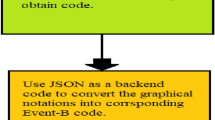Abstract
The traditional system design method cannot guarantee the dependence of large-scale and complex real-time embedded software. The model constructed by UML and other semi-structured modeling languages does not support simulation and verification, nor can it find requirements omission and logic contradiction. The Extended Hierarchical State transition Matrix model (EHSTM) which supports hierarchical modeling and concurrent States is proposed. The formal modeling of large-scale software system is simplified by model hierarchy. All relations between any two complex system concepts are clarified by hierarchical States and state parallelization, and the parallel behavior modeling of system is supported at the same time. After the model is constructed, it can be simulated and verified by a bounded model verification tool "GarakabuII". C source codes can be generated automatically after model checking and verification. In this way, system developers can focus only model design, which simplifies the system design process. Finally, a system design tool ZIPC based on EHSTM model is designed. Aiming at the problems of atomicity violation and data race in concurrent program development, ZIPC tool is used to construct the model, and the above problems can be effectively solved by experimental verification.


























Similar content being viewed by others
References
About the Unified Modeling Language specification Ver. 2.5. (2013) https://www.omg.org/spec/UML/2.5/About-UML/
Buhr, P.A., Dice, D., Hesselink, W.H.: Dekker’s mutual exclusion algorithm made RW-safe. Concurr. Comput. Pract. Exp. 28(1), 144–165 (2016)
Clarke, E.M., Grumberg, O., Peled, D.: Model Checking. MIT Press, Cambridge (1999)
Embedded System development Process Reference guide Ver.2.0 (2012) [2020] Written and edited by Software Engineering Center, Technology Headquarters, Information-technology Promotion Agency, Japan. https://www.ipa.go.jp/files/000028853.pdf. Accessed Jan 2012
ISO/IEC11411 (1995) Information technology—Representation for human communication of state transition of software
Jeyanthi, N., Abraham, A., Mcheick, H.: Ubiquitous Computing and Computing Security of IoT. Springer, New York (2019)
Kamel, M., Karray, F., Gueaieb, W., Khamis, A.: Autonomous and intelligent systems. In: Second International Conference, AIS 2011, Burnaby, BC, Canada, June 22–24 (2011)
Masahiko, W.: Embedded software development environments. IPSJ Mag. 45(1), 10–15 (2004)
Sangiovanni-Vincentelli, A., Sifakis, J.: Embedded software. In: Second international conference, EMSOFT 2002 Grenoble, France, October 7–9 (2002)
Yamagata, Y., Kong, W., Fukuda, A., Van Tang, N., Ohsaki, H., Taguchi, K.: A formal semantics of extended hierarchical state transition matrices using CSP. Form. Aspects Comput. 26(5), 943–962 (2014)
Author information
Authors and Affiliations
Corresponding author
Rights and permissions
About this article
Cite this article
Masahiko, W., Zhou, K., Li, Y. et al. EHSTM: a formal model of embedded software and research on several key issues. CCF Trans. HPC 3, 365–382 (2021). https://doi.org/10.1007/s42514-021-00082-9
Received:
Accepted:
Published:
Issue Date:
DOI: https://doi.org/10.1007/s42514-021-00082-9




